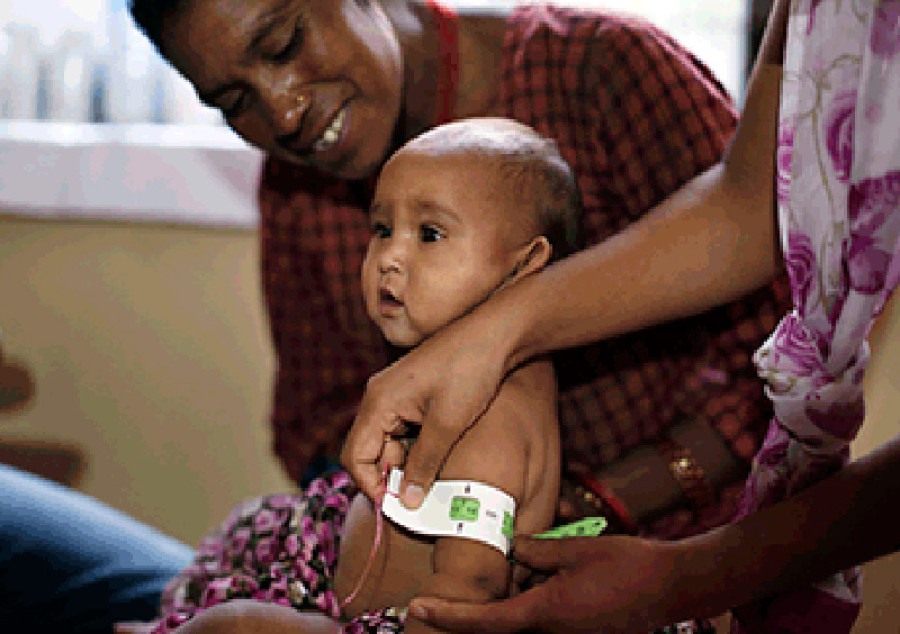Opinion
No time to waste
In South Asia, more than eight million under-five children are dangerously thin, a condition known as severe wasting, while 63 million children are stunted, meaning they are too short for their age.
Jean Gough
In South Asia, more than eight million under-five children are dangerously thin, a condition known as severe wasting, while 63 million children are stunted, meaning they are too short for their age.
Wasted or stunted children fail to thrive and are more likely to die because their immunity to infections is weakened by a lack of nutrients. Many will not do well at school, because the same nutrient deficiencies that cause poor growth also impair brain development. As adults, stunted children earn 20 percent less than their well-nourished peers, impeding their escape from the poverty trap and costing nations up to 11 percent of their gross national income.
The good news is the immense human and development costs of poor nutrition can be prevented. And we know what works.
Irreversible impacts
Efforts to prevent stunting and wasting should focus on the first 1,000 days between conception and the child’s second birthday as the impact of poor nutrition on brain development in early life is often irreversible.
Adolescent girls, women and mothers need vitamins and minerals for their own nutrition. These nutrients are also essential for the growing foetus when women enter pregnancy. Newborn babies need breastfeeding in the first crucial hour after births and need to be exclusively breastfed—with no other foods or liquids, not even water—for the next six months. Then infants need sufficient and frequent amounts of a variety of food groups, together with continued breastfeeding until they are at least two years of age. Throughout this period, good quality health care and hygiene and sanitation practices are vital to prevent and treat childhood illnesses such as diarrhoea, which can precipitate wasting and stunting.
However, prevention efforts sometimes fail and children become so severely wasted that urgent treatment is essential. During my visit last December to the Far West Region of Nepal, I was thrilled to meet Pramila who brought her baby girl to the Community Centre to receive weekly treatment for severe wasting. After two weeks of treatment, Baby Rana was gaining weight and curiosity, and it made me feel very happy to see the programme bring back her smile. Pramila told me she was grateful that the Centre was in her community, otherwise she would have had to carry Rana for three hours to reach the nearest Primary Health Centre, a distance that may have cost Rana her life. Unfortunately, this is the reality for many under-five children in South Asia.
Across South Asia, over 95 percent of severely wasted children are not receiving appropriate care and treatment. This is unacceptable as severely wasted children are up to nine times more likely to die, and those who survive often go on to suffer poor growth and development.
Moral and economic imperative
Why are so few children with severe wasting receiving nutritional care and support they need, and what can be done?
First, there is a perception that the treatment of severe wasting is only relevant in emergency or humanitarian contexts, while prevention is only applicable in stable or development settings. This is not true—every country in South Asia needs to step-up actions to both prevent and treat malnutrition in both crisis and stable settings.
Second, families often do not realise that their severely wasted children need urgent help. Community-based workers can use a simple colour-coded tape to measure the arm circumference of children in the community and identify those that need to be referred for treatment. This can vastly increase the number of severely wasted children that are identified.
Third, there is a continued belief that children with severe wasting need to be treated in a hospital or health facility. In the past, hospital admission was the only option available, however, we now know that children can be safely treated in their homes and communities provided they have no medical complications. This community-based treatment is highly beneficial. It brings services close to where families live, is less costly to families and the health system, and reduces the risk that a child will contract an infection from another patient in a hospital setting—allowing more children to be successfully treated.
Fourth, the lack of political attention to nutrition translates into low public investments in nutrition programmes. The consequences of poor nutrition on children’s growth and development, human dignity and economic growth demand greater and more efficient investments in proven actions to prevent and treat malnutrition.
It is a moral and economic imperative that we build the capacity of every health and community system in South Asia to deliver services at scale for millions of severely wasted children, alongside services to prevent malnutrition.
We know what is needed and why—and there is no time to waste.
Gough is regional director of Unicef Regional Office for South Asia




 21.82°C Kathmandu
21.82°C Kathmandu










